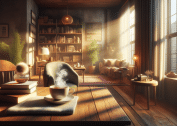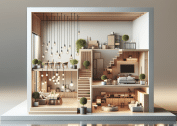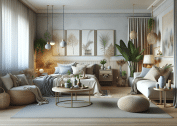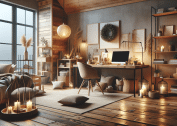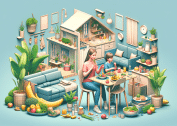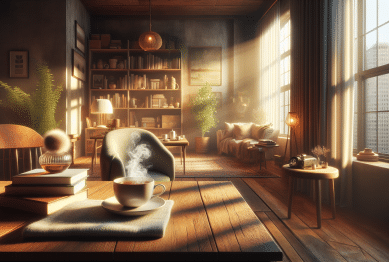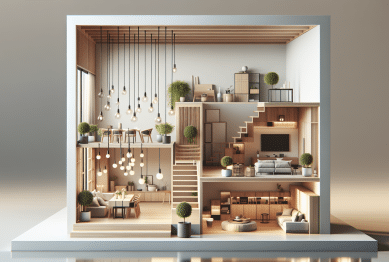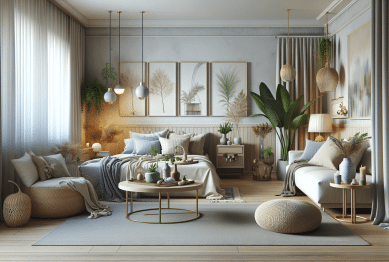Curious about how home decor trends reshape everyday spaces? This guide explores evolving interior design styles, practical ways to refresh rooms, and the emotional benefits of crafting a personalized look. Whether minimalist or eclectic, learn how people transform homes with creativity, sustainability, and comfort.
Exploring Interior Design Trends That Inspire Change
Home decor has never been more exciting. Styles shift as people seek both comfort and flair, blending timeless elegance with daring colors or minimalist lines. Trends like Japandi—a mix of Japanese minimalism and Scandinavian warmth—have captivated many who crave simplicity, nature, and practical beauty in each room. Others embrace maximalist interiors, where patterns, art, and color bursts create bold, unique atmospheres.
Interior design trends often reflect social and environmental issues, such as sustainability and wellbeing. As more households choose eco-friendly materials, think bamboo floors or recycled glass tile, the landscape is changing. There is growing demand for organic textiles and energy-saving lighting. Choosing these options not only feels good but often leads to better air quality and a more relaxed living environment.
Flexible spaces have also become a focus in current decor trends. Open-plan layouts, movable partitions, and modular furniture support changing routines from remote work to family gatherings. These design choices give rooms dual purposes—study by day, entertainment hub by night. Creating a sense of flow encourages creativity and supports healthy, productive lifestyles within the home.
Minimalism and Maximalism: Finding Your Home Style
Minimalism appeals to those who seek space and serenity. This style emphasizes clean lines, functional pieces, and neutral colors. Rooms often feature a few carefully chosen furnishings, maximizing both space and calm. Many people discover that uncluttered environments reduce stress and make it easier to focus. Minimalism isn’t just a trend—it’s a philosophy about living with less, but loving it more.
Maximalism, on the other hand, dares people to experiment. Think wallpapers with intricate prints, shelves bustling with books and personal memorabilia, and eclectic rug layers. This style welcomes bold art, vintage finds, and vibrant textiles—all harmonized by a confident eye. It’s expressive and joyful, transforming every corner into a conversation piece and infusing the home with personality.
Choosing between minimalism and maximalism often starts with self-reflection. Some blend both: minimalist foundations with bursts of maximalist accents, crafting a dynamic yet cohesive look. The essential ingredient is authenticity—letting individual taste drive decisions. This personal approach leads to interiors that comfort and inspire, with each item adding meaning and story.
Creative Ways to Refresh Your Living Space
Refreshing home decor need not break the bank. Easy updates, such as switching out throw pillows or adding statement lamps, deliver transformations. Rearranging existing furniture fosters new perspectives and can make rooms feel brand-new. A well-placed mirror will brighten an entryway, while fresh houseplants provide color and clean the air naturally.
Creating feature walls—perhaps with bold paint, textured wallpaper, or a curated gallery—dramatically shifts a room’s energy. Experimenting with lighting, by layering floor lamps, ceiling pendants, and candles, changes daily moods. For renters especially, removable decals and modular shelving offer excellent flexibility without permanent alterations. Embracing these strategies sparks continuous evolution in the home environment.
Tapping into DIY projects adds a personal stamp to home design. Crafting your own shelves, revitalizing second-hand furniture, or weaving homemade textiles transforms ordinary materials into conversation pieces. These creative outlets often nurture relaxation and pride, turning simple rooms into inviting sanctuaries for both guests and residents alike.
The Impact of Color Psychology in Home Decor
Color choices profoundly influence mood. Soft blues and greens evoke tranquility, making them popular for bedrooms and bathrooms. In living areas, yellows and corals lift spirits and encourage social gatherings. People often gravitate toward hues that reflect seasonal changes, cultural traditions, or personal milestones, making color selection a distinctly emotional decision.
Accent colors can be used strategically. A vibrant orange pillow or deep navy wall provides visual breaks and signals shifts in activity or mood within open spaces. Designers often create balance by pairing bold colors with soft neutrals, ensuring that changes feel energizing but not overwhelming. Homes become adaptable by simply updating small colorful accessories.
Understanding color psychology helps in addressing practical needs. For example, soft pinks in entryways set calming tones after bustling commutes. Green shades can enhance focus in home offices. Natural light also plays a role—daylight intensifies bright tones, while warm bulbs mellow their effect at night. The versatility of color allows endless refinement of ambiance for every situation.
Sustainable and Eco-Friendly Decor Choices
Eco-conscious lifestyles are shaping home decor. Sustainable furniture crafted from responsibly managed forests or reclaimed wood is on the rise. Many opt for organic cotton bedding, natural fiber rugs, and low-VOC paints. These choices limit environmental impact while promoting healthier homes. Choosing vintage or second-hand pieces reduces waste and adds history to new surroundings.
Biophilic design is another emerging approach. Integrating plants, water features, and outdoor views helps reconnect indoor living with nature. This trend supports emotional well-being and boosts creativity. Research indicates that homes with meaningful green accents see higher satisfaction and increased productivity among those who work remotely or study at home (Source: https://www.health.harvard.edu/mind-and-mood/greening-your-office).
Local crafts and handmade decor support both artisans and sustainability. Using regionally sourced pottery, textiles, or art not only reduces carbon footprints but also celebrates local identity. These elements ground rooms in a sense of place, making design choices feel both culturally rich and environmentally kind. This mindful approach has a growing following among new homeowners and renovators alike.
Personalization and Emotional Benefits of Curated Living Spaces
The emotional benefits of curating your space are significant. Personal collections—be it framed photos, travel souvenirs, or inherited furniture—tell stories and foster connection. Individuals who personalize their homes often report an increased sense of security and happiness. Even small, sentimental touches can transform spaces from basic to beloved sanctuaries.
Home decor choices have ripple effects beyond aesthetics. For some, a well-organized space can lower anxiety and aid in relaxation. Others find that dedicated hobby zones encourage creative exploration or aid recovery from stress. Personal touches, such as hand-painted vases or customized bookshelves, support self-expression and pride in accomplishment.
Personalization also benefits shared spaces. Families, roommates, or partners collaborate to balance individual tastes and routines, making communal areas enjoyable for all. This process reinforces communication, compromise, and a sense of belonging. A home that fits the unique needs of its inhabitants ultimately supports wellbeing as much as it expresses style.
References
1. American Society of Interior Designers. (n.d.). Home trends today. Retrieved from https://www.asid.org/resources/resources/view/resource-center/196
2. The Spruce. (n.d.). Minimalism vs. maximalism: Which decor style is right for you? Retrieved from https://www.thespruce.com/minimalism-vs-maximalism-5188841
3. Harvard Health Publishing. (2022). Greening your office: The benefits of adding plants. Retrieved from https://www.health.harvard.edu/mind-and-mood/greening-your-office
4. EPA. (n.d.). Indoor air quality: Creating a healthy home environment. Retrieved from https://www.epa.gov/indoor-air-quality-iaq
5. Psychology Today. (n.d.). How color impacts our daily lives. Retrieved from https://www.psychologytoday.com/us/blog/the-main-ingredient/201409/how-color-impacts-our-daily-lives
6. World Green Building Council. (n.d.). Health, wellbeing and productivity in offices. Retrieved from https://www.worldgbc.org/news-media/health-wellbeing-and-productivity-offices


